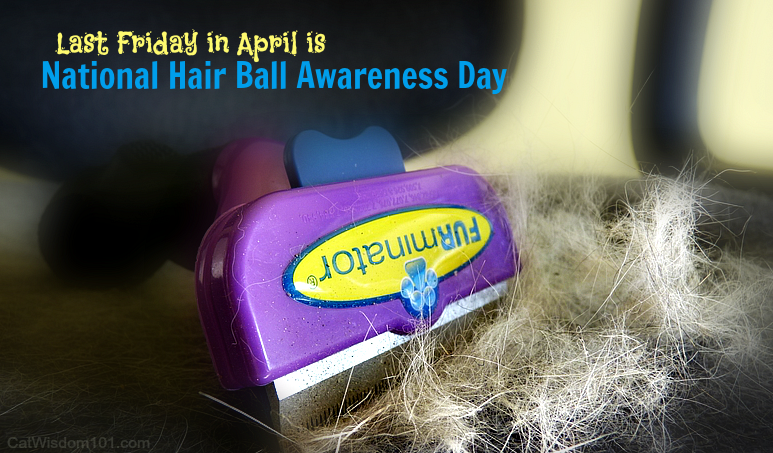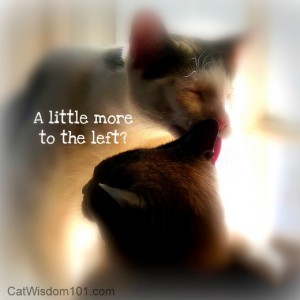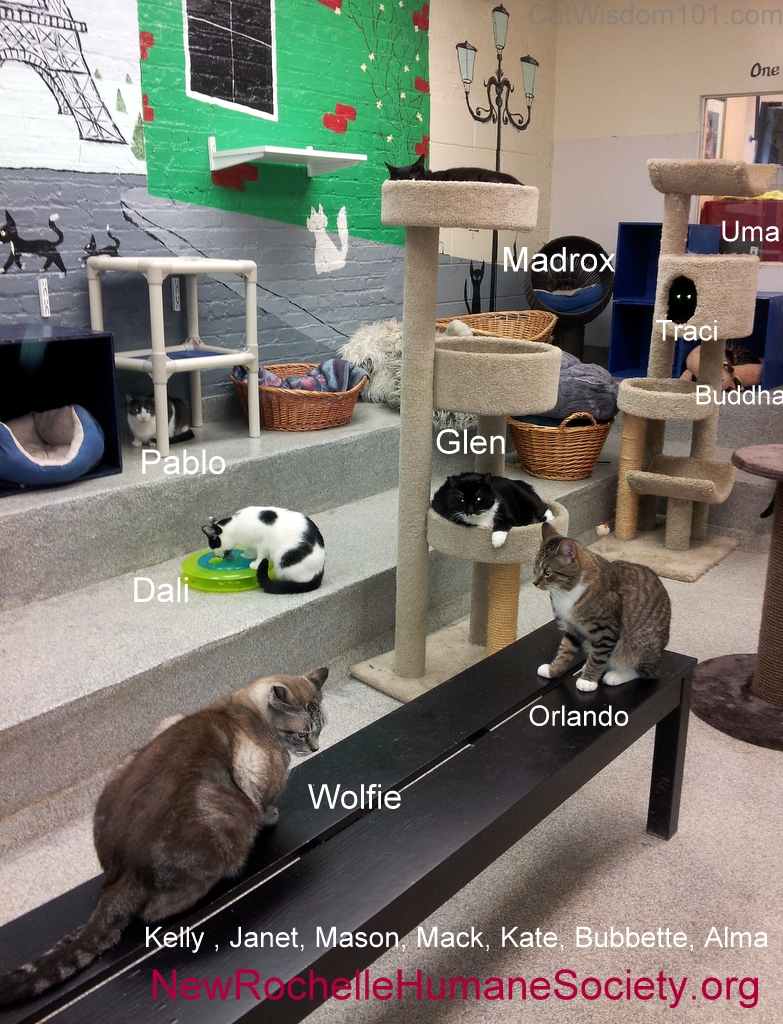
Vet 101: How To Avoid Shedding, Hair Balls & Cat Hack Attacks
Just in time for National Hair Ball Awareness Day, our vet, Dr. Richard Goldstein addresses why some cats shed more than others and what to do about the dreaded ick factor of hair ball hack attacks.
Shedding the undercoat is a normal part of the hair cycle of the cat, and is a way for cats to rid their coats of dead hairs. Usually, cats will groom themselves enough to keep up with the loose hairs. But, if the amount of shedding exceeds the cat’s grooming behavior, you might find yourself with an extra carpet or two on your floor.
The amount of shedding can be affected by many factors:
-
stress (a big one!)
-
the weather (seasonal changes can affect hair growth) especially in spring.
-
allergies, poor nutrition
-
skin diseases especially ringworm, skin mites, fleas, infection
-
specific breeds shed more i.e. Persians, Himalayans,
-
internal medical conditions i.e. Irritable bowel disorder
It’s also important to distinguish between shedding, which involves losing the undercoat, and hair loss (alopecia), which involves shedding the primary coat. If you tug gently on the hair, and leave a bald spot (or if you see bald spots), that means there is hair loss, and a visit to the vet is in order.
Nutrition plays an important role in skin and hair health. Even though two cats are eating the same food, their bodies can react differently. Consider two individual people eating lots of pizza: one may stay skinny as a rail, the other may gain lots of weight. Foods affect individuals individually.
Here are a few suggestions for dealing with shedding:
- If the shedding is excessive, or there is hair loss, have your vet examine your kitty to make sure one of those medical conditions is not the source.
- Consider a diet with a higher nutritional value.
- If you are in a flea-endemic area, make sure you’re using a flea preventative.
- In some cats, omega fatty acid vitamin supplements can help keep the skin and coat in good shape so that there is less shedding.
- Long-haired cat breeds like Persians and Himalayans require regular grooming, ideally professionally. Breeds known to shed less include Siamese, Sphynx and the Rex.
- Some cats will allow you to assist them by brushing or combing out the undercoat. Some people (and cats) like gadgets such as The Furminator. Others like gentle curry combs, that look like oven mitts. There are also gentle brushes that you can stick to the wall that your cat can rub up against to brush himself! Most cats don’t like wire brushes. Some cats just hate being brushed. Sometimes you can trick those stubborn kitties with a soft brush that you can use for short periods while petting them. Give a treat after as a reward. Brush as often as you need to, and as often as he’ll let you, especially if your cat is prone to mats.
And, of course, with excessive shedding and grooming can come excessive hairballs. So, keep a good hairball remedy close by. It’s much nicer to remove the excess hair ahead of time than to wake up in the middle of the night and step in a hairball.

Editor’s note: We have used a Furminator with excellent results but also like using a flea comb to keep on top flea or tick issues.
Petromalt is a popular hairball/constipation remedy but it’s a petroleum by-product. There is a “natural” version with hydrogenated oils which isn’t much healthier. I consider it the fast food of over-the-counter remedies: tasty but not to be used often. We’re doing a combo diet of grain-free with raw with essential fatty acids found in fish oil and don’t usually have many hairballs. Our nightly grooming sessions are our cats’ treat of the day. And they get a treat after too!
What hairball remedy works well for you?






21 Comments
Pingback:
Felissa
Thanks for the great tips. My kitties are constantly hacking up hairballs :/
The Swiss Cats
Good reminder ! Mum gave me brushies this morning, even if she didn’t know that it was National Hairball Awareness Day in the US, I like it ! Purrs
Skeeter and Izzy
We have a big variety of shed patterns among us nine. We get brushed or combed as much as we will allow and Mom removes some more with just firm petting. We get a bit o the hairball stuff in a tube a couple of times during peak shed season.
Luvs,
Skeeter and Izzy and the Feral Gang + Twig and Peanut and Romeo >^..^<
Sometimes, Cats Herd You
Thanks for the reminder about shedding vs. hair loss. Some people really don’t understand the difference.
Ashton gets Furminated when she allows it. Doesn’t submit to much brushing, and Newton doesn’t allow it at all (thus his manscaping adventures this week). We agree about diet… we all shed much less on grain free, wet food.
Sue Brandes
Great post. Some good suggestions too.
Sparkle
This reminds my human – Boodie needs FURminating really bad! I just had my flea comb check and I’m good!
CatInTheFridge
The Great Shed is a upon us!! This means the vacuum comes out daily. Wah! We’re on omega 3s, though, as you suggested, so maybe it’s not as bad as it would otherwise be. – Crepes.
Angel AbbyGrace
This is excellent advise. I wish Annabelle liked being brushed more often maybe it will grow on her. *sigh*
da tabbies o trout towne
doodz….eye get a wee small amount o coconut oil each day….
in me 7 yeers eye haz had a hairball less than 5 times….
now that eye haz said thiz, wait til two nite round 3:17 am
😉
♥ tuna of moon
Layla Morgan Wilde (Cat Wisdom 101)
Thanks for the reminder. We love coconut oil. I use it Odin’s rough paws.
The Island Cats
We get FURminated when the mom remembers to do it.
Deztinee High
Meowsy gweat infuwmation. glad you’s likin’ you furminator. Meez has long hair and a foo hairballs but mommy uses a bawbews comb on meez fur.Meez sisfur has da showt fur and lots more hairballs. Mommy uses da same comb on her. Da altewnatives are vewy nice and neat but a bit pwicey as mommy is on a fixed income. But wes’ enjoy weadin’ ’bout dem just in case sumday wes’ can afford one. Hav a Pawwsum day!!
Luv and Hugs and Kitty Kisses 😀
Dezi
Daisy the Curly Cat
I am a Devon Rex kitty and I hardly shed at all, and never have hairballs! When Harley came here from the shelter, his fur was sort of stiff. We eat a raw food diet with a squirt of high-quality omega 3 fish oil and Harley has the softest coat now!
CATachresis
Thanks that’s helpful advice. Austin loves being brushed, it’s his drug of choice! I think he sheds about right for his coat and we are not in a particularly hot country either! I think he might need vitamins though, as he is really not eating – this has always been a problem with him! He is very small. Anyway he has his annual shot at the end of the summer, so will get the vet to check him over.
Cheysuli
We love our furminator. We have the midsized one for Gemini and she loves it. In face, holding it up will get her to jump on the Woman’s lap for a bit of furmination. Sometimes she gets tired and leaves. Other times the Woman has to stop before she’s done because it will pull too much hair out. I am okay with it but Ichiro doesn’t like it. The Woman finds that it is not as useful on a smooth coated cat like me.
boomermuse
Thanks for your feed back. So great for longer hair and so much for short hair or a Siamese.
Ingrid King
I agree that there’s a strong connection between nutrition and healthy hair coat. Allegra and Ruby are my first raw-fed kitties, and they barely shed. Neither of them has had a single hairball, ever. They also have the softest and shiniest coats of any cat I’ve ever had.
As for hairballs, too many at owners consider them a normal part of life with cats, and they shouldn’t be. Frequent hairballs can actually be early indicators of inflammatory bowel disease.
Rather than using petroleum based hairball remedies for lubrication, (a cat is not a car!), I would recommend a grain-free canned or raw diet. And if a cat vomits hairballs on an almost daily basis, it’s most definitely time for a trip to the veterinarian!
boomermuse
I agree. None of our guys shed much. The remedies are not for regular use.
Liz | Natural Cat Care Blog
Before we were able to incorporate raw, we found that just adding the omega 3 fish oils (we use Iceland Pure, but Carlson and Nordic Naturals are good too) to canned food = almost no shedding at all!
Kathryn
Ched sheds like that dog in the furminator video. Mao not so much. We have a brush with a wire side and we brush Ched daily, otherwise we’d have a house full of thick fur on the floor.